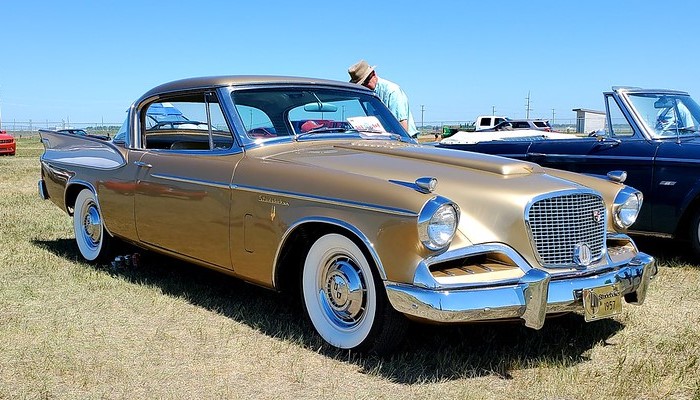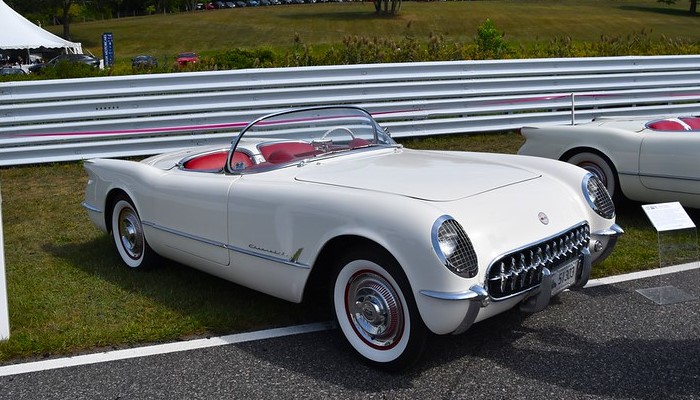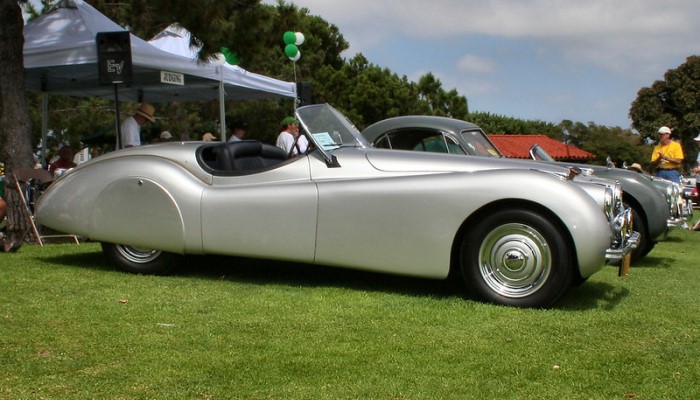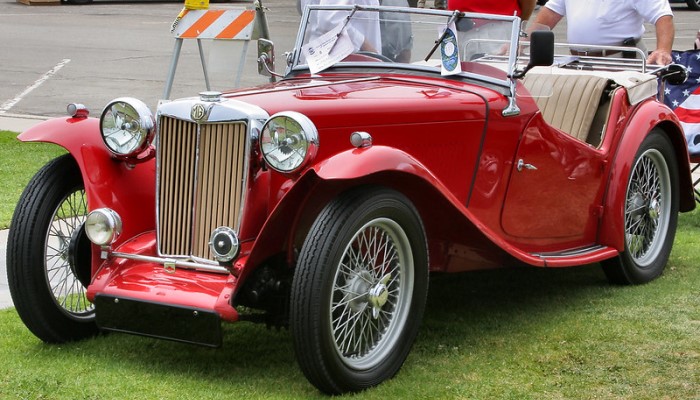1955 Ford Thunderbird
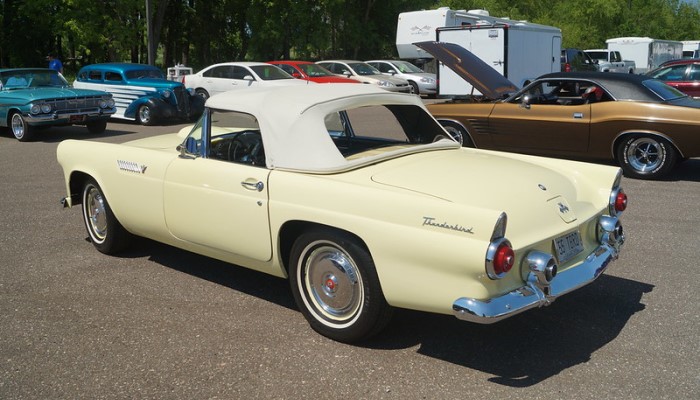
Photo: "1955 Ford Thunderbird" by Crown Star Images
European Influence
In the early 1950s, Americans who stayed in Europe for work after the end of World War II returned home. Many of them brought with them unusual, by American standards, European sports cars.
Sleek and sporty MGs, Triumphs, and Jaguars have found their way into the hearts of the military. This trend was noticed by car manufacturers, and they began to look for an adequate response.
Chevrolet was one of the first to test the market by launching the Corvette. Not wanting to be left behind, Ford set out with the Thunderbird.
The creators of the Ford Thunderbird considered three: Lewis D. Crusoe, Frank Hershey, and George Walker. Crusoe, the former CEO of General Motors, was retired; the other two were Ford employees; Hershey was a designer; and Walker was head of styling.
After visiting the Paris Motor Show, Crusoe and Walker were so inspired by sports cars that when they returned, they immediately convinced Hershey to get down to work, the result of which was an open two-seater.
As usual, the hardest part was naming the car. Out of more than 5,000 offers, they settled on Thunderbird.
Although both the Ford Thunderbird and the Chevrolet Corvette were two-seat sports cars, they had little in common. Unlike the Chevrolet, the Thunderbird was both designed and built as a "compact personal luxury" car with no sporting ambitions.
The body of the car was made of steel, not fiberglass, and instead of a six-cylinder engine, there was a 292 cu in (4.8-liter) Y-block V8.
Trying to keep the cost of the car within the given limits, the designers, as far as possible, used parts from other Ford models that were in production at that time.
Despite the economy, the Ford Thunderbird had both style and comfort. Depending on the wishes of the client, it was possible to install an automatic or manual transmission.
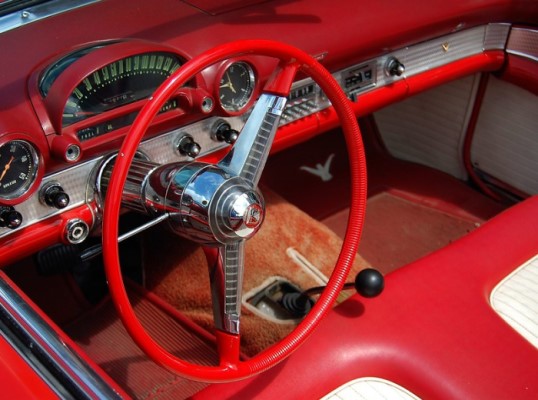
The dashboard had a clock, a tachometer, and a speedometer marked up to 150 miles per hour. The folding soft top was raised and lowered electrically. For an additional fee, it was possible to purchase a removable hard top.
For the first time, the public saw the Thunderbird in February 1954 at the Detroit Auto Show, and already in September, the serial car entered dealerships. During the first year, more than 16,000 vehicles were produced, and for a total of three years of production, a little over 53,000 vehicles of this version.
More About the Engine and Transmission
Under the hood of this iconic car was a powertrain that was built to deliver exhilarating speed and a thrilling driving experience.
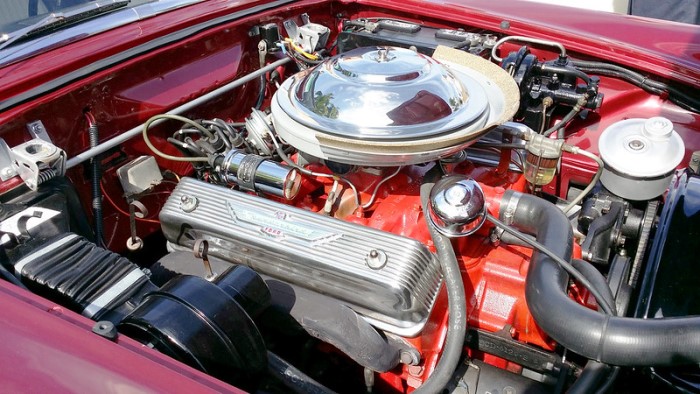
Photo: "1955 Ford Thunderbird Engine" by Eric Friedebach
At the heart of the Thunderbird's power was a 292 cu in (4.8-liter) V8 engine capable of generating an impressive 198 horsepower. This engine was a work of art, combining power and efficiency in a seamless manner.
It featured a dual exhaust system, which not only enhanced its performance but also produced a deep, rumbling sound that sent shivers down the spine of any car enthusiast.
In addition to its power, the Thunderbird's engine was also equipped with various advanced technologies for its time. It featured a Holley four-barrel carburetor that ensured optimal fuel delivery, allowing the engine to unleash its full potential with every press of the accelerator.
The engine also boasted Ford's innovative Y-Block design, which enhanced its durability and overall performance.
To harness the power of this mighty engine, the Thunderbird was equipped with a smooth-shifting three-speed automatic transmission.
This transmission offered seamless gear changes, allowing the driver to effortlessly glide through the gears and make the most of the engine's power band.
Furthermore, the Thunderbird featured advanced suspension and steering systems that enhanced its handling capabilities. It had coil springs in the front and leaf springs in the rear, along with a solid axle design.
These components worked in harmony to provide a comfortable ride while ensuring precise control and responsiveness on the road.
1955 Ford Thunderbird Value
The value of a 1955 Ford Thunderbird can vary depending on various factors such as its condition, mileage, originality, and any modifications or customizations.
On average, however, a 1955 Ford Thunderbird in good condition can be valued around $20,000 to $120,000. This classic car is highly sought after by collectors and enthusiasts, contributing to its relatively high value in the market.
Additionally, factors such as rare color options, original features, and documented history can also impact the value of a 1955 Ford Thunderbird.
It's important to consult with a knowledgeable appraiser or conduct market research to get an accurate estimate of the current value for a specific Thunderbird model.
Parts for 1955 Ford Thunderbird
If you're a proud owner or a fan of the classic 1955 Ford Thunderbird, finding parts to restore or maintain your prized possession can be both exciting and daunting.
To embark on this journey, you'll need to explore various avenues that cater to classic car enthusiasts. Here are some places where you can look for parts to keep your 1955 Ford Thunderbird running smoothly:
1. Classic Car Forums: Online forums dedicated to classic cars often have a vibrant community of enthusiasts, including Thunderbird owners. Join these forums and participate in discussions; you'll find fellow enthusiasts who can guide you towards reputable sources for parts.
2. Classic Car Restoration Shows and Swap Meets: Attend classic car restoration shows and swap meets held regularly across the country. These events attract vendors specializing in vintage car parts, and you'll likely stumble upon a treasure trove of components for your Thunderbird.
3. Specialized Stores: Look for stores specifically dedicated to classic cars in your area. Some may have a physical presence, while others may operate solely online. These stores tend to stock a wide range of original and aftermarket parts specifically tailored to various classic car models.
4. Online Marketplaces: Online marketplaces like eBay, Etsy, and Craigslist are excellent platforms for finding parts for your 1955 Thunderbird. With their extensive listings, you can search for specific components or even stumble upon rare finds that you might not find anywhere else.
5. Thunderbird Owners' Clubs: Joining a Thunderbird owners' club can be a great way to connect with fellow enthusiasts who share your passion for preserving these beautiful machines. Members often have insider knowledge about the best sources for original parts and can provide valuable recommendations.
6. Antique Junkyards: Exploring antique junkyards can be an adventure in itself. While it may take some hunting, you may stumble upon hidden gems by rummaging through a pile of discarded cars. Always ask the owner or staff if they have any Thunderbird parts or if they know any other places that might stock them.
7. Online Forums and Social Media Groups: Join online forums and social media groups dedicated to classic cars and Thunderbird owners. By engaging with like-minded individuals, you can gather recommendations, ask for help, and even find fellow Thunderbird enthusiasts looking to sell or trade parts.
8. Classic Car Dealerships: Contact classic car dealerships specializing in vintage Fords or Thunderbirds. These dealerships may have a selection of parts in stock, or they can help you source them from reliable suppliers.
Remember, part availability may vary depending on the rarity of the component or the demand in the market.
Be patient and persistent in your search, and remember that the journey of bringing your Thunderbird back to its former glory is often as exciting as the destination itself. Happy hunting!

Unique Car Zone Team
A group of several fans of everything that moves on four wheels, a few article creators, a couple of marketing strategists, designers, web developers, and lots of coffee.




